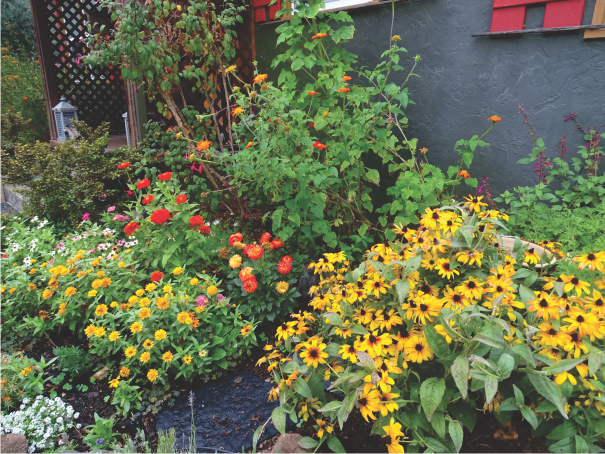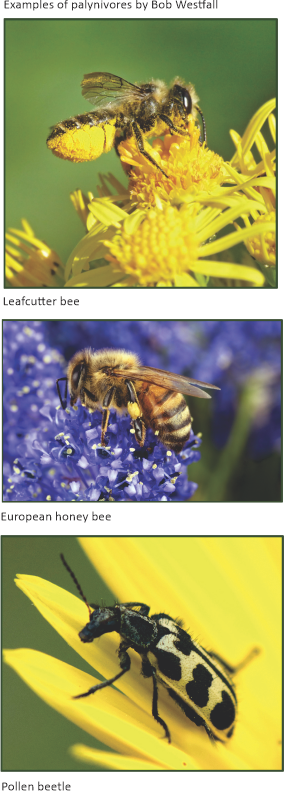by Mel Kendall

A pollinator garden's diverse plants and colorful blooms attract and help to support a variety of birds, butterflies, moths, and beneficial insects year-round. These visitors play a critical role in sustaining our ecosystem by helping our plants reproduce. Pollinator gardens provide the habitat, plants, pollen, and nectar to help us care for our wildlife partners. Transfer of pollen is the plant's goal, and nectar and pollen are the pollinator's reward. If plants bloom earlier due to climate change, and species respond to seasonal changes in light, the food supply may not be available when the migrating species pass through. A pollinator garden can provide the habitat and food migrating pollinators need and give the gardener personal satisfaction in the process.

Install plants that will attract pollinators.
• Lots of color will attract birds, bees, butterflies and other pollinators: Different pollinators see and are attracted to different colors. Create an overall ‘crazy quilt' color scheme rather than a monotone one.
• Have enough mass of each plant type. Provide “one stop shopping” by grouping the same color/type of plants in large clumps
• Have a variety of plants. Mix it up. Plant multiple varieties of pollinator friendly plants in your garden. Planning for a longer nectar and pollen season when selecting plants can help encourage early arrivals and latecomers.
Create a Habitat
All creatures (including us) have the four same basic needs in order to thrive. To entice and support any wildlife in our gardens, we need to provide food, water, shelter, and a place to rear and nurture young. We need to do it in a way that supports the entire ecosystem, which means avoiding toxic chemicals.
Food
• Plan for the whole life cycle of the pollinator. The pollinator will need food and shelter to grow become adults and provide safe places to breed and raise their young.
• Variety of plant species and bloom times. Some pollinators arrive in early spring, others are just passing through and still others stay for throughout the growing season. Plan for each of these scenarios when selecting plants for your pollinator garden.
• Long duration and sequence of bloom. Some pollinators are specialized. Make sure to have plants that bloom early and have a rotating sequence of blooms to feed specialized pollinators.
• Different shapes of bloom for different pollinators. Some pollinators can reach down into a trumpet shaped bloom to get the pollen and others are perchers that will just alight on a bloom to gather the pollen. Provide for both.
• Plant in 3-4 foot blocks for visibility and access. Some pollinators can only see certain colors and/or are attracted to certain plants so plant similar colored plants in blocks to facilitate the collections of pollen.
• High quality pollen and nectar. Some plants provide pollen but not as nutritious or as plentiful that provided by other plants. Plant as many types as possible that provide the best/most plentiful pollen.
• Plant in color (pollinators see color differently!) Find out which pollinators see what color(s) and choose and locate your plants with that in mind.
Rewards and Payback
Nectar provides the sugars, amino acids and carbohydrates for adult pollinators. As they make their rounds throughout the garden to seek their reward of the nectar, the pollinators are dusted with pollen which they casually disburse thus pollinating or paying back the plants for the ‘reward' that they provided.
Pollen provides protein, fats/lipids, starch, vitamins, and minerals to create the bee loaf that feeds larval bees. Also, numerous species of insects (bees, wasps, ants, beetles, flies, butterflies, moths), mites, spiders, and birds consume pollen as a food source. To more efficiently collect pollen, these palynivores have evolved various adaptations in their body parts and behavior. Pollinators like hummingbirds distribute pollen more casually as it collects on beak and head feathers.
Water Many birds prefer running water, but that is a challenge for delicate pollinators. Butterflies and bees can't swim and need shallow water or wet gravel or mud so they can stand and sip, a process called puddling. They draw nutrients from water and benefit from water that we would consider dirty. From studies by Butler and by Bonoan, “during much of the year they found that bees had a strong preference for sodium-rich water, regardless of plant diet. In the fall, however, when pollen is scarce, they showed a preference for water sources containing calcium, magnesium, and potassium, all of which are found in pollen. This demonstrated that honey bees have the ability to switch water sources to compensate for dietary nutrient deficiencies.” So, in your water basin, leave a few leaves, some gravel, and a stick for perching. And maybe a bit of salt or ash for mineral content. Wet gravel or mud is great.
Shelter Some pollinators will need places to feel safe and sheltered either temporarily or long term. Leave some brush, dead wood, or unpruned shrubbery or grasses for shelter and overwintering. Leave some dead blooms for seed and to provide shelter through the winter for pollinators. Wait to cut back perennials and shrubs until early spring when the air begins to warm and creatures begin to stir. Add structures to encourage certain pollinators. If you are a neat gardener, designate places in your yard to be just a little messy and learn to tolerate just a little chaos in your garden. A little tolerance makes us better neighbors.
A place to raise young All creatures need a safe place for their young. To provide safe places, create undisturbed hiding places, provide nesting materials and pieces of dead wood for holes and habitat. Many native bees and other insects use mud for nesting material and need access to bare ground (slightly damp if possible, otherwise they have to dig for it). Artificial nesting sites must suit individual pollinators and they must be kept clean or they risk mold and disease.
Sustainability What exactly does ‘sustainability' mean? According to Google & Oxford Language: ‘the ability to be maintained at a certain rate or level'; ‘Avoidance of the depletion of natural resources in order to maintain an ecological balance.' How can we do this in our gardens? Avoid using toxic chemicals in your garden, use the Integrated Pest Management Method instead. No-till gardening practices keep carbon and nutrients sequestered in the soil and ground nesting pollinators undisturbed. Use patience and tolerance, rather than over-grooming your garden. Capture water run-off and let it sink into the ground to boost groundwater and purify it of pollutants from roofs and hard surfaces. Use compost to keep the life in your soil strong, which will keep your plants and their visitors strong in turn. Consider the whole system as a community or even an organism.
Support entire life cycle Many pollinator species have adapted to use specific plants for food and protection. Provide plants with high quality nectar to attract and support adults, and their larvae. This is where tolerance comes in. Larvae eat a lot, leaving chewed plants and frass behind. If this interests you, plant where you can watch the action. If it is less tidy than you like, plant larval food plants in a back corner of the garden.
Information link: American Farm Bureau Foundation for Agriculture
UC Davis-plight of the pollinators